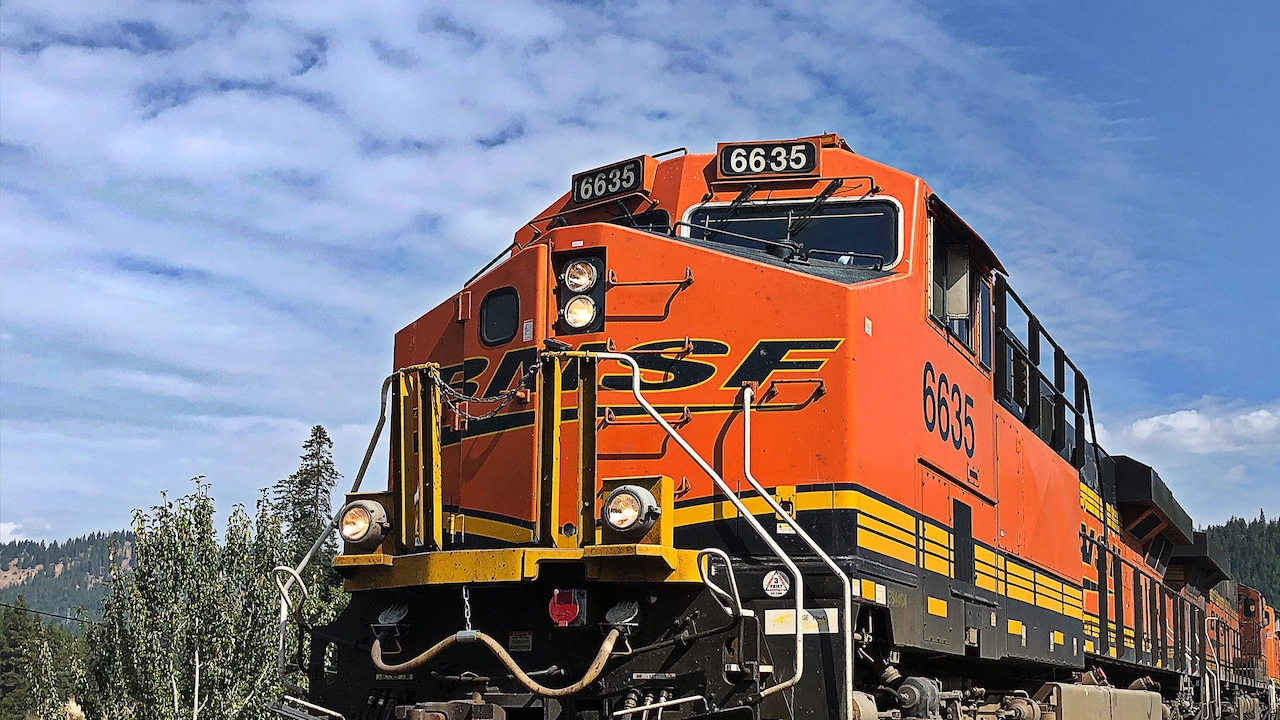
AAR Backs BNSF, Calls STB Common Carrier Obligation Decision ‘Disastrous’
Written by Marybeth Luczak, Executive Editor
The Association of American Railroads (AAR) supports BNSF’s appeal of the Surface Transportation Board’s (STB) recent preliminary injunction requiring the Class I to this year transport millions of tons of coal from Navajo Transitional Energy Company, LLC’s (NTEC) mine in Big Horn County, Mont., to an export facility in British Columbia, Canada, according to a “friend of the court” (amicus curiae) brief filed Aug. 31 with the U.S. Court of Appeals for the Fifth Circuit (download below).
The STB in June “ordered BNSF to provide common-carrier service to NTEC in 2023 to transport (a) 4.2 million tons of coal from Montana to Canada for export and (b) if resources ‘are available,’ … an additional 1 million tons,” BNSF wrote in its July 28 lawsuit against the federal agency.
“That total volume would be unprecedented for NTEC, and yet, because this is common-carrier service, NTEC has no obligation to ship anything at all,” the railroad continued. (The railroads’ common carrier obligation requires carriers to provide service upon “reasonable request.”) “BNSF is now enjoined to stand ready to move billions of pounds of coal, never mind the effects on its network and the diversion of resources away from serving other shippers. In theory, without resource constraints, NTEC could request whatever it wanted, and BNSF would easily carry NTEC’s shipments. But in the real world, shippers must make reasonable requests, railroads must respond reasonably in light of their limited resources and the competing demands of other shippers, and regulators must judge the reasonableness of the request and the response.”
BNSF said that the Board’s decision is “divorced from those realities, and it must be vacated.”
The case stems from NTEC’s April 14, 2023 application to the STB seeking an emergency service order pursuant to 49 U.S.C. § 11123.
The STB in June said it found that “NTEC prevailed on the four-part test for granting injunctive relief.” Specifically, the STB reported finding “that NTEC was highly likely to succeed on the merits of its claim that BNSF violated its statutory common carrier obligation to transport the volume of coal tendered by NTEC. On this prong, the Board found that NTEC’s request for service was reasonable, in light of BNSF’s historical performance, and factual statements in BNSF’S pleadings and at oral argument that BNSF has the capacity to provide the minimum service requested by NTEC.” STB said it also found that “NTEC was likely to suffer irreparable harm, such as significant damage to its reputation as a dependable supplier in the global coal marketplace, which cannot be remedied by money damages. The Board found that balancing the needs of other BNSF customers did not weigh against an injunction because the record establishes that BNSF can comply with the injunction and still meet the needs of other shippers. Finally, the Board found that an injunction serves the public interest because NTEC has shown that it plays a critical role in the Navajo Nation’s economy. The Board further acknowledged that there is a public interest in accessing the rail network.”
“The common carrier obligation is a core tenet of the Board’s regulation of the freight railroad industry and is a pillar of the railroads’ responsibility to our country’s economy,” STB Chairman Martin J. Oberman said during the June decision announcement. “Today’s decision reflects the majority’s finding that the common carrier obligation requires a railroad to provide service on a customer’s request that is within the railroad’s capacity to provide.”
Oberman added, as the STB said it has previously held: “The common carrier duty reflects the well-established principle that railroads ‘are held to a higher standard of responsibility than most private enterprises.’”
Board members Patrick Fuchs and Michelle Schultz dissented with separate expressions.
AAR Speaks Out
AAR, in its brief, wrote that the “common carrier obligation is a foundational aspect of the railroad industry, and AAR has worked closely with its members on issues related to the obligation—including exchanging information and collecting and analyzing relevant case law—particularly over the past year. As a result of this work, AAR believes it is in a unique position to assist this Court [U.S. Court of Appeals for the Fifth Circuit] in the resolution of this matter.”
AAR told the Court that there are policy-related aspects of the common carrier obligation that are relevant “to the disposition of this case, as well as the railroad industry at-large and those who rely on freight rail service.” They are:
• The STB’s “treatment of ‘capacity’ as an oversimplified math problem, the answer to which defines the scope of the common carrier obligation.” AAR explained that a railroad’s capacity “is a dynamic concept that cannot be captured in a simple equation, such as that implied by the Board: crew + trains = capacity. Rather, there are numerous operational and commercial factors that impact capacity and service because rail is a network industry that ‘involves not just resources but other shippers’ demand and external factors.’” The association noted that the “appropriate role of ‘capacity’ in the common carrier analysis is to protect carriers from being required to invest capital in order to increase their ability to provide common carrier service. Generally, railroads are prohibited from exiting their investments and have an obligation to provide service absent government permission to ‘abandon’ a line.”
• The STB’s “use of a single aspect of a failed contract negotiation between BNSF and NTEC and its determination that this facet be binding on BNSF alone.” According to AAR, the STB “cherry-picks terms from the contract negotiations to establish the level of common carrier service that BNSF would be required to provide, without requiring any consideration or reciprocal commitments from NTEC to BNSF. Thus, while the Board has obligated BNSF to provide record levels of service, ‘the injunction imposes no obligations on NTEC—not to utilize [acquired or repositioned] train sets, not to pay liquidated damages for failing to meet a minimum-volume commitment, or indeed to do anything.’” AAR called the obligation “wasteful.”
• The STB’s decision is an “affront to expressly stated Congressional intent to encourage private contracting between railroads and shippers.” According to AAR, “Congress has been explicit in its direction that rail transportation should be governed by market forces—and that private contracting be incentivized.” It pointed out that “[p]rior to the partial deregulation of the industry, private contracts were prohibited and nearly all freight rail transportation was governed by the common carrier obligation—which almost bankrupted the entire industry. The Staggers Rail Act of 1980 changed that, specifically allowing for private contracts. Congress emphasized that government intervention in the rail system is to be exceptional and infrequent.”
• The STB decision will cause “harm to incentives for long-term investment in the rail network.” AAR reported that “[c]ontracting permits flexibility, promotes stability, and encourages long-term investment—such as in specialized equipment and specific infrastructure, which can only be justified by the predictability of contracts. Further, contract terms, such as liquidated damage provisions and volume expectations allow both parties to effectively manage, plan, and control their resources and allocate risk. It follows then that a reduced incentive to contract will result in reduced stability and long-term investment, potentially resulting in long-term degradation of the network.”
• The “potential use—and abuse—of STB proceedings to make winners and losers among shippers requesting rail resources.” According to AAR, the STB’s “role is to ensure that decisions made by railroads are sound and reasonable”—not to “decide matters anew.” In the past, AAR said, the STB “has been clear that, ‘[a]bsent exceptional circumstances, [it] do[es] not intrude in railroads’ day-to-day operational practices, because a Board-mandated change in a carrier’s operational practices designed to benefit one shipper might well have negative impacts vis-à-vis other shippers’ … Despite this governing principle, the Board broke with precedent to realign the competitive market.” AAR reported that in this case, “one shipper gained the Board’s favor, receiving first claim on any incremental capacity that might emerge on a specific route … NTEC is not alone in wanting an increase in its export coal shipping volume; it is only alone in seeking to enforce that desire before the Board.” AAR pointed out that the “negative impacts of disrupting the expectations of other shippers spread far beyond those individual shippers. Indeed, such disruptions impact others throughout the supply chain, as well as consumers who receive their goods via rail.” While “the common carrier obligation does not require a carrier to maintain service levels for one shipper that will degrade service overall,” AAR reported. “that is exactly the position that the [STB’s 3-2] majority has taken.” Railroads, AAR said, “have a strong incentive to put their network and resources to their best use. Accordingly, when the Board steps in to rearrange things, it begins to play a dangerous game of picking winners and losers. And cases like this cannot simply be dismissed as harmless one-off events.”
AAR concluded that “[b]y breaking with established precedent and ignoring explicit Congressional objectives, the Board has created a common carrier obligation that will prove disastrous for the rail network and, ultimately, the public at large. The Court should reject the majority’s approach and grant the relief sought by BNSF.”
Railway Age Capitol Hill Contributing Editor Frank N. Wilner commented: “There is a fascinating antagonism here between STB Chairman Martin J. Oberman and the railroads. Where the AAR argues in its brief that government should not be choosing winners and losers, Oberman—between the lines and with an STB majority—appears to be arguing that common carrier railroads shouldn’t themselves be choosing winners and losers by manipulating what capacity they have and to whom they wish to make that capacity available and on what terms. This is what the Fifth Circuit is being asked to referee in the absence of Congress never having clearly defined the common carrier obligation. The Board has an exceedingly steep climb to prevail, as the Fifth Circuit Court of Appeals is the most conservative of its peers and two sharp dissents to the STB [3-2] decision at issue were from the Board’s two Republicans—Michelle A. Schultz and Patrick J. Fuchs.”



